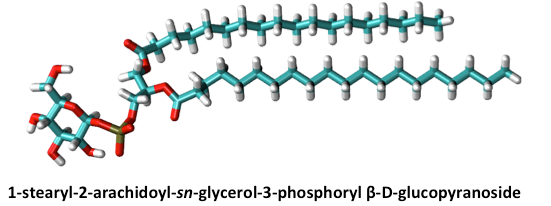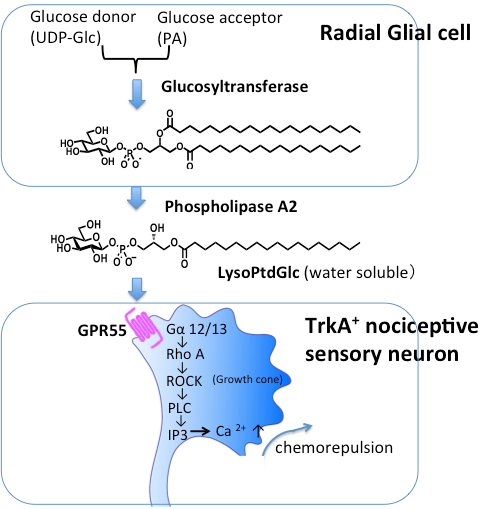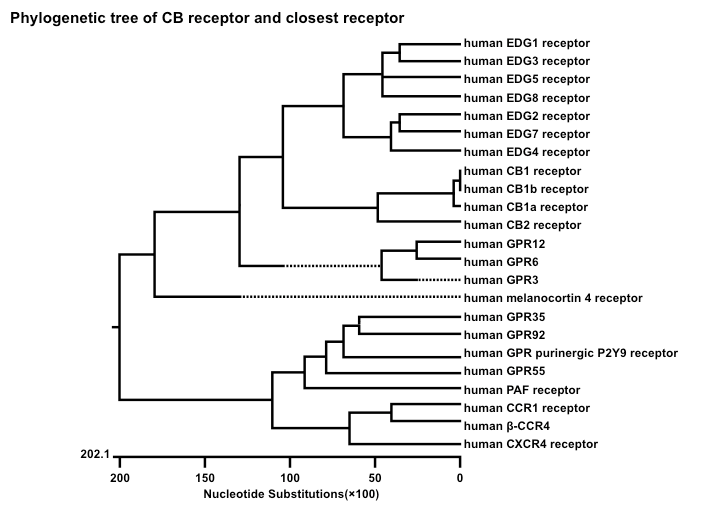Research Theme
6. Neuron-Glia interaction mediated by Lyso-phosphatidylglucoside
Yoshio Hirabayashi, Yeon-Jeong Kim, and Yasuko Nagastuka
Laboratory for Molecular Membrane Neuroscience, RIKEN Brain Science Institute
Cholesterol/sphingolipid complex is thought to form lipid raft in biological membrane. It serves as key assembly and sorting platforms for cell-cell interactions or signal transduction complexes and modulates multiple cellular processes, such as axonal growth and guidance of neuronal growth cones, neuron-glia interactions. We have demonstrated that a novel glycolipid phosphatidylglucoside (PtdGlc)-enriched lipid raft is present in developing neural membranes and HL60 cell[1]. The glycolipid purified from fetal rodent brain exists in the form of a single saturated molecular species with 18:0 at position sn-1 and 20:0 at position sn-2 of the glycerol backbone (Fig.1)[2].
 Fig. 1. Chemical structure of phosphatidylglucoside.
Fig. 1. Chemical structure of phosphatidylglucoside.
PtdGlc is composed exclusively of a single pair of saturated fatty acid chains;
the sn-1 chain, stearic acid (C18:0) and the sn-2 chain, arachidic acid (C20:0).
Because of this fatty acid composition, PtdGlc forms lipid microdomain/lipid raft
distinct from cholesterol-based sphingolipid domains, on the outer leaflet of
the plasma membrane.
More interestingly we have demonstrated that it exists in enantiomeric form, that is about 10~20 % of the glycolipid contains the phosphoglucose moiety attached to sn-1 position of sn-2,3-diacylglycerol backbone. Recently we found that LysoPtdGlc in the developing spinal cord is synthesized and released by radial glia to regulate the targeting of nociceptive but not proprioceptive central axon projections[3]. We also identified the G protein-coupled receptor GPR55 as a receptor specific for LysoPtdGlc, and GPR55 deletion or LysoPtdGlc loss-of-function in vivo caused the abnormal location of nociceptive axons into proprioceptive zones (Fig.2). Our findings show that LysoPtdGlc/GPR55 axis is a lipid-based signaling system in neuron-glia communication for neural development.
GPR55 was first identified as cannabinoid receptors (Fig.3). Then, it was reported that it functioned as receptor for structurally very similar but different lyso-lipid, lysophosphatidylinositol or 2-AG. However, it is determined to be lysoPtdGlc as an endogenous ligand for GPR55. The receptor is now expected to be drug target for inflammation, pain, and others. Further study is essential for understanding physiological and pathophysiological roles of LysoPtdGlc/GPR55 signaling axis.
 Fig. 2. Glia-neuron interaction mediated by lysoPtdGlc
Fig. 2. Glia-neuron interaction mediated by lysoPtdGlc
and its specific receptor, GPR55.
 Fig. 3. Phylogenetic tree of cannabinoid receptor and related GPCRs
Fig. 3. Phylogenetic tree of cannabinoid receptor and related GPCRs
【References】
[1] Nagatsuka Y, Hara-Yokoyama M, Kasama T, Takekoshi M, Maeda F, Ihara S, Fujiwara S, Ohshima E, Ishii K, Kobayashi T, Shimizu K, Hirabayashi Y. Carbohydrate-dependent signaling from the phosphatidylglucoside-based microdomain induces granulocytic differentiation of HL60 cells. Proc Natl Acad Sci U S A 100, 7454-7459 (2003).
[2] Nagatsuka Y, Horibata Y, Yamazaki Y, Kinoshita M, Shinoda Y, Hashikawa T, Koshino H, Nakamura T, Hirabayashi Y. Phosphatidylglucoside exists as a single molecular species with saturated fatty acyl chains in developing astroglial membranes. Biochemistry 45(29), 8742-8750 (2006).
[3] Guy AT, Nagatsuka Y, Ooashi N, Inoue M, Nakata A, Greimel P, Inoue A, Nabetani T, Murayama A, Ohta K, Ito Y, Aoki J, Hirabayashi Y*, Kamiguchi H* (*Corresponding co-authors) “Glycerophospholipid regulation of modality-specific sensory axon guidance in the spinal cord” Science 349(6251):974-977 (2015).
